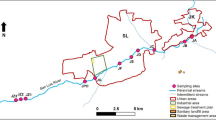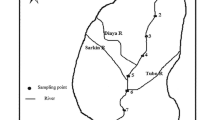Abstract
In statistics, the identification of environmental criticalities, one of the primary goals of environmental monitoring and management, translates into the detection of spatial outliers. Detected in relation to purposely defined sets of indicators, both global and local outliers are pivotal in the identification not only of the severity and spread of criticalities, but also of their nature and causes. The present research exemplifies a procedural framework to identify environmental criticalities, using two different approaches for the detection of spatial outliers in river ecosystems related to several sets of parameters (organic C, inorganic C, Ca, Co, Cr, Fe, K, Mg, Mn, N, Na, P, S, Si, V, Zn, Cl−, F−, NO3−, SO42−, chlorophyll a, chlorophyll b, pheophytin a, pheophytin b, total carotenoids, pH, and electrical conductivity), including emerging contaminants. To this end, indicator sets diagnostic for specific criticalities, derived from an empirical dataset of water quality parameters, were employed, using detection techniques based on geographically weighted principal component analysis and a modified pairwise Mahalanobis distance–based algorithm. Clear and accurate criticality scenarios were derived, highlighting both the strengths and the limitations of the proposed approach, especially in relation to the classic threshold-based methods.


Similar content being viewed by others
References
Bellino A, Alfani A, De Riso L, Gregorio R, Pellegrino T, Baldantoni D (2020) A promising cosmopolitan biomonitor of potentially toxic elements in freshwater ecosystems: concentration gradients in sensitive areas. Ecol Indic 109:105801
Boudt K, Rousseeuw P, Vanduffel S, Verdonck T (2019) The minimum regularized covariance determinant estimator. Stat Comput:1–16
De Maesschalck R, Jouan-Rimbaud D, Massart DL (2000) The Mahalanobis distance. Chemometr Intell Lab 50:1–18
Ernst M, Haesbroeck G (2017) Comparison of local outlier detection techniques in spatial multivariate data. Data Min Knowl Disc 31:371–399
Filzmoser P, Todorov V (2013) Robust tools for the imperfect world. Inf Sci 245:4–20
Filzmoser P, Garrett RG, Reimann C (2005) Multivariate outlier detection in exploration geochemistry. Comput Geosci 31(5):579–587
Filzmoser P, Ruiz-Gazen A, Thomas-Agnan C (2014) Identification of local multivariate outliers. Stat Pap 55(1):29–47
Folt CL, Chen CY, Moore MV, Burnaford J (1999) Synergism and antagonism among multiple stressors. Limnol Oceanogr 44(3):864–877
Geissen V, Mol H, Klumpp E, Umlauf G, Nadal M, van der Ploeg M, van de Zee SEATM, Ritsema CJ (2015) Emerging pollutants in the environment: a challenge for water resource management. Int Soil Water Conserv Res 3:57–65
Gollini I, Lu B, Charlton M, Brunsdon C, Harris P (2015) GWmodel: an R package for exploring spatial heterogeneity using geographically weighted models. J Stat Softw 63(17):1–52
Harris P, Brunsdon C, Charlton M, Juggins S, Clarke (2014) A multivariate spatial outlier detection using robust geographically weighted methods. Math Geosci 46:1–31
Hubert M, Vandervieren E (2008) An adjusted boxplot for skewed distributions. Comput Stat Data An 52:5186–5201
Jørgensen SE, Xu L, Costanza R (2010) Handbook of ecological indicators for assessment of ecosystem health, 2nd edn. CRC Press
Kaplunovsky AS (2005) Factor analysis in environmental studies. HAIT J Sci Eng B 2(1–2):54–94
Kriegel H-P, Kröger P, Schubert E, Zimek A (2012) Outlier detection in arbitrarily oriented subspaces. IEEE Computer Society 12th International Conference on Data Mining. 379-388
Küpper H, Seibert S, Parameswaran A (2007) Fast, sensitive, and inexpensive alternative to analytical pigment HPLC: quantification of chlorophylls and carotenoids in crude extracts by fitting with Gauss peak spectra. Anal Chem 79(20):7611–7627
Lu B, Harris P, Charlton M, Brunsdon C (2014) The GWmodel R package: further topics for exploring spatial heterogeneity using geographically weighted models. Geo Spat Inf Sci 17(2):85–101
R Core Team (2018) R: a language and environment for statistical computing. R foundation for statistical computing, Vienna
Reimann C, Garrett RG (2005) Geochemical background - concept and reality. Sci Total Environ 350:12–27
Reimann C, Filzmoser P, Garrett RG (2005) Background and threshold: critical comparison of methods of determination. Sci Total Environ 346:1–16
Ro K, Zou C, Wang Z (2015) Outlier detection for high-dimensional data. Biometrika 102(3):589–599
Robinson RB, Cox CD, Odom K (2005) Identifying outliers in correlated water quality data. J Environ Eng 131(4):651–657
Schubert E, Zimek A, Kriege H-P (2014) Local outlier detection reconsidered: a generalized view on locality with applications to spatial, video, and network outlier detection. Data Min Knowl Disc 28:190–237
Schubert E, Weiler M, Zimek A (2015) Outlier detection and trend detection: two sides of the same coin. IEEE Computer Society 15th International Conference on Data Mining Workshops. 40-46
Sendzimir J, Magnuszewski P, Gunderson L (2018) Adaptive management of riverine socio-ecological systems. In: Schmutz S, Sendzimir J (eds) Riverine ecosystem management, aquatic ecology series 8. Springer, pp 301–324
Sousa JCG, Ribeiro AR, Barbosa MO, Pereira MFR, Silva AMT (2018) A review on environmental monitoring of water organic pollutants identified by EU guidelines. J Hazard Mater 344:146–162
Teodosiu C, Gilca A-F, Barjoveanu G, Fiore S (2018) Emerging pollutants removal through advanced drinking water treatment: a review on processes and environmental performances assessment. J Clean Prod 197:1210–1221
Tockner K, Pusch M, Borchardt D, Lorang MS (2010) Multiple stressors in coupled river–floodplain ecosystems. Freshw Biol 55(Suppl. 1):135–151
Todorov V, Filzmoser P (2009) An object-oriented framework for robust multivariate analysis. J Stat Softw 32(3):1–47
Acknowledgements
The authors are grateful to the “Cilento, Vallo di Diano e Alburni” National Park (Italy) administration for authorizing the use of the dataset employed in the present research.
Author information
Authors and Affiliations
Contributions
AB and DB conceived the research, collected data, performed the analyses and wrote the paper. AA and LDR provided support and helpful suggestions in setting up and revising the manuscript. All the authors read and approved the final version of the manuscript.
Corresponding author
Ethics declarations
Conflict of interest
The authors declare that they have no conflict of interest.
Additional information
Responsible editor: Marcus Schulz
Publisher’s note
Springer Nature remains neutral with regard to jurisdictional claims in published maps and institutional affiliations.
Electronic supplementary material
ESM 1
(PDF 3039 kb).
Rights and permissions
About this article
Cite this article
Bellino, A., Alfani, A., De Riso, L. et al. Multivariate spatial analysis for the identification of criticalities and of the subtended causes in river ecosystems. Environ Sci Pollut Res 27, 30969–30976 (2020). https://doi.org/10.1007/s11356-019-07198-0
Received:
Accepted:
Published:
Issue Date:
DOI: https://doi.org/10.1007/s11356-019-07198-0




